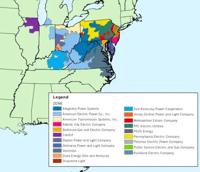Grid manager PJM's summer forecast shows a greater risk of peak demand leading to contracted customers reducing their electricity use.
PJM forecasts summer energy use to peak at just over 154,000 megawatts. If that happens, PJM should have adequate reserves to maintain reliability.
This season marks the first time in PJM’s annual assessment that available generation capacity may fall short of required reserves in an extreme heat event that would result in an all-time PJM peak load of more than 166,000 MW.
In that case, PJM would call on contracted demand response programs to meet its required reserve needs. Demand response programs pay customers who have opted in to reduce their electricity use in times of system emergencies.
The National Weather Service predicts hotter-than-normal summer conditions, especially in the Atlantic seaboard states.
PJM’s record summer peak load was set at 165,563 megawatts in 2006. Last year, PJM’s summer peak was about 152,700 MW, and 147,000 MW in 2023. PJM has approximately 179,200 MW of generation capacity this summer, as well as approximately 7,900 MW of contracted demand response.
One megawatt can power about 800 homes.
PJM continues to raise concerns about the supply and demand imbalance driven by generator retirements and the slow build of new resources as demand accelerates.
PJM and its stakeholders have taken a number of measures to bring new generation resources online and maximize the availability of existing resources in the short and long term.
The grid operator has faced. criticism over the slowness of getting new generating sources on line and working through a backlog of projects.
Steps aimed at improvementing the situation include:
- Interconnection Process Reform – PJM has streamlined its process through which new generation connects to the grid. Additional automation in the interconnection process, along with increased staffing over the past several years, has improved quality while reducing the backlog by 60%. PJM on April 10 also announced a multiyear collaboration with Google and Tapestry to deploy AI-enhanced tools to further streamline PJM’s interconnection process.
- Reliability Resource Initiative – PJM on May 2 announced the projects chosen for this one-time program to boost reliability in the PJM footprint. It includes 51 shovel-ready generation projects with 9,300 MW in capacity that can come online by 2030 or 2031.
- Surplus Interconnection Service – PJM obtained federal FERC approval to streamline the use of the unused portion of interconnection service for facilities that cannot or do not operate continuously, every hour of every day, year-round (such as adding battery storage to a renewable site).
- Capacity Interconnection Rights Transfer – A reform package endorsed by PJM stakeholders and currently pending review by FERC would allow an expedited interconnection process for a replacement resource seeking to use the capacity interconnection rights of a retiring resource.
PJM plans to issue guidance for inverter-based resource owners, typically solar and wind, to take steps so that units stick withy necessary standards and operational guidelines to support reliable grid operations.
“This outlook at a record peak heat scenario reflects our years-long and mounting concerns as we plan for enough resources to maintain grid reliability,” said Aftab Khan, executive vice president – operations, planning & security. “All resources within PJM’s footprint should be prepared to respond when called upon.”











(0) comments
Welcome to the discussion.
Log In
Keep it Clean. Please avoid obscene, vulgar, lewd, racist or sexually-oriented language.
PLEASE TURN OFF YOUR CAPS LOCK.
Don't Threaten. Threats of harming another person will not be tolerated.
Be Truthful. Don't knowingly lie about anyone or anything.
Be Nice. No racism, sexism or any sort of -ism that is degrading to another person.
Be Proactive. Use the 'Report' link on each comment to let us know of abusive posts.
Share with Us. We'd love to hear eyewitness accounts, the history behind an article.